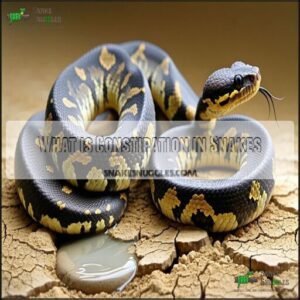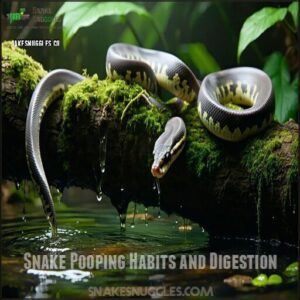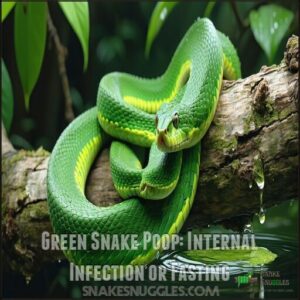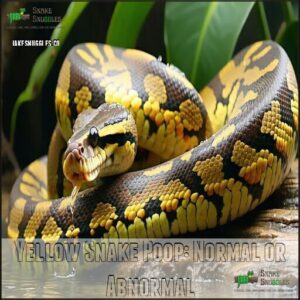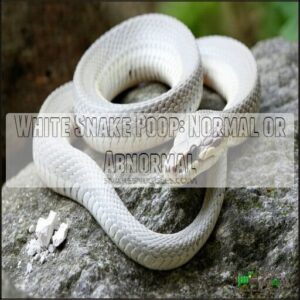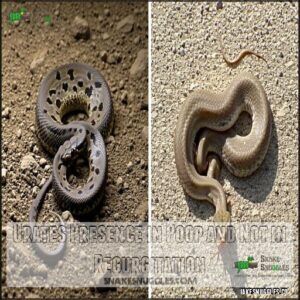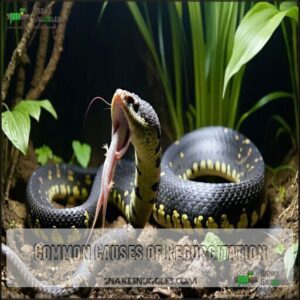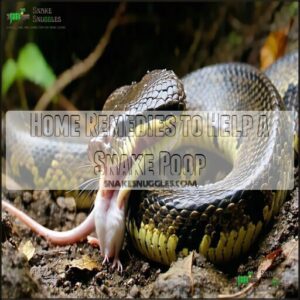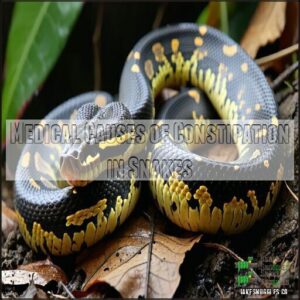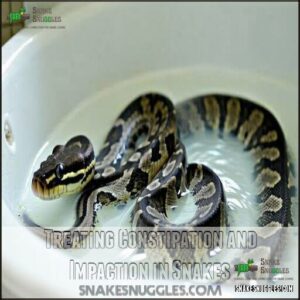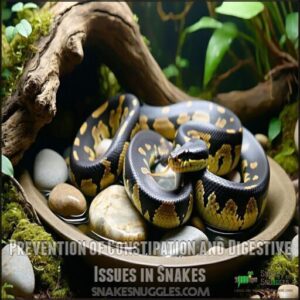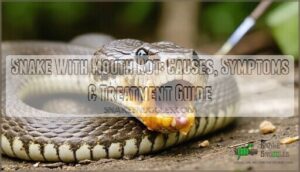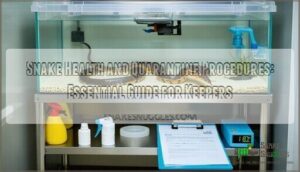This site is supported by our readers. We may earn a commission, at no cost to you, if you purchase through links.
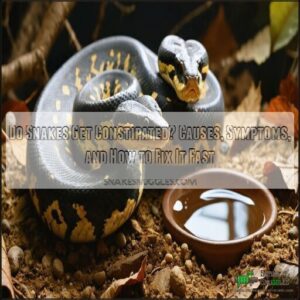 Yes, snakes do get constipated, and it’s more common than you’d think!
Yes, snakes do get constipated, and it’s more common than you’d think!
Your slithery friend might be backed up if they haven’t pooped in 2+ weeks or show signs of discomfort.
The usual culprits are temperatures that are too cool, dehydration, or prey that’s too large.
You’ll notice a constipated snake may have a visible bulge, reduced appetite, or unusual behavior.
Unlike humans who can reach for fiber supplements, snakes need specific help—warm soaks often do the trick like a spa day for your scaly buddy.
Proper husbandry is key to keeping things moving smoothly through their single-pipe plumbing system.
Table Of Contents
- Key Takeaways
- What is Constipation in Snakes
- Snake Pooping Habits and Digestion
- Abnormal Poop Colors and What They Mean
- How to Tell The Difference Between Poop and Regurgitation
- How Often Should a Snake Poop
- Home Remedies to Help a Snake Poop
- Medical Causes of Constipation in Snakes
- Treating Constipation and Impaction in Snakes
- Prevention of Constipation and Digestive Issues in Snakes
- Frequently Asked Questions (FAQs)
- Can Snakes get constipated?
- Can eating bananas cause constipation?
- How to prevent constipation in snakes?
- How do you know if a snake is constipated?
- What happens if a snake doesn’t poop?
- Why is my snake not passing a stool?
- How to help a snake with constipation?
- How do I tell if my snake is constipated?
- How do you treat a constipated reptile?
- How do you stop a snake from getting constipated?
- Conclusion
Key Takeaways
- Yes, snakes do get constipated and you’ll notice signs like bloating, reduced appetite, no poops for 2+ weeks, or straining without results.
- Your snake’s constipation is typically caused by temperatures that are too cool, dehydration, oversized prey, or ingestion of substrate material.
- You can help your constipated snake with warm water soaks (15-20 minutes daily), increasing humidity, offering fresh water, and feeding smaller prey items.
- You’ll prevent constipation by maintaining proper temperatures (75-90°F depending on species), ensuring adequate hydration, using digestible substrates, and monitoring your snake’s regular pooping schedule.
What is Constipation in Snakes
You’ll know your snake is constipated when it hasn’t pooped for an extended period, often showing a swollen belly and decreased appetite.
Just like us on a bad day, snakes can’t move things along when they’re dehydrated, their enclosure is too cool, or they’ve eaten something too large or inappropriate.
Causes of Constipation
Snakes frequently get constipated due to several key factors affecting their digestive system. Understanding these causes helps prevent uncomfortable impactions.
Common snake constipation causes include:
- Dehydration effects that harden waste
- Improper temperature regulation slowing metabolism
- Dietary issues like oversized prey or insufficient fiber
- Foreign objects from ingestion of substrate or bedding
- Stress factors disrupting normal digestive function
Think of your snake’s digestive tract as a one-way highway—when there’s a traffic jam, nothing moves until it’s cleared! You may need to explore warm water baths to help relieve the constipation.
When constipation strikes your snake, imagine their digestive tract as a one-way highway with a serious traffic jam—nothing’s moving until that roadblock clears!
Symptoms of Constipation
Recognizing a constipated snake involves watching for 3 key warning signs:
- Bloated Abdomen: Your snake’s midsection may appear unusually swollen or distended as waste builds up.
- Appetite Issues: A constipated snake often refuses food or shows decreased interest in meals.
- Straining Without Results: You might notice your pet making efforts to defecate without success.
Additional symptoms include unusual lethargy (your normally active ball python might suddenly spend all day hiding) and visible discomfort.
Like humans stuck in a traffic jam, constipated snakes get cranky and sluggish when things aren’t moving as they should.
Constipation Vs Impaction
Think of your snake’s digestive system like plumbing—constipation is a slow drain, while impaction is a complete blockage.
The severity differences are vital: constipation from dehydration causes temporary discomfort, but impaction from foreign objects can be life-threatening.
Diagnostic methods include observing bloating for constipation versus no waste production for impaction.
Treatment efficacy varies; warm soaks often help constipation, while snake impaction typically requires veterinary intervention and possibly surgery.
Snake Pooping Habits and Digestion
You’ll need to know your snake’s bathroom habits to spot problems early, just like watching a child’s potty patterns tells you they’re healthy.
Your slithery friend’s digestion system works slowly and efficiently, turning that mouse dinner into waste that exits through their cloaca on a schedule as unique as their personality.
Frequency of Pooping in Snakes
After understanding constipation basics, you’re probably wondering: just how often should your snake be pooping?
The frequency of your snake’s bowel movements directly reflects their meal intervals. Most snakes defecate within 7-10 days after eating, though this varies widely by species.
Your ball python might go 2-3 weeks between poops, while a corn snake typically processes meals faster. Environmental impact plays a significant role too. During brumation or shedding, expect defecation patterns to slow considerably.
- Species variation: Active hunters (like rat snakes) poop every 2-7 days; ambush predators (like pythons) might go weeks
- Age influence: Youngsters with faster metabolisms defecate more frequently
- Health indicators: Multiple poops between meals could signal diarrhea
- Meal intervals: Larger prey takes longer to digest than smaller items
Remember, knowing your particular snake’s digestion process is key to spotting potential problems. This understanding can help you identify if your snake’s defecation pattern is normal or if there might be an issue that needs attention, such as a sign of illness.
Normal and Healthy Poop Appearance
Now that you know how often your snake poops, let’s look at what healthy droppings should resemble.
Normal snake poop typically consists of dark brown or black feces paired with chalky white urates.
You’ll often notice a clear mucus consistency surrounding these components.
Healthy urates should be white or slightly yellow, while normal feces should be firm but not hard.
After digestion, you might spot prey remnants like fur or scales.
Proper hydration levels guarantee smooth passage and ideal snake poop consistency, which is also influenced by proper hydration levels.
Abnormal Poop Colors and Their Meaning
After getting familiar with normal snake droppings, it’s time to explore what abnormal colors reveal about your pet’s health.
Your snake’s poop color speaks volumes about their internal well-being. When the usual brown/black changes, it’s like your reptile sending you a message through their waste.
Three key color changes to watch for:
- Green feces: Often indicates fasting or an intestinal infection. If your snake hasn’t eaten recently, this might be normal—otherwise, it’s time for a vet visit.
- Yellow feces: Perfectly normal for urates, but concerning when it appears in the actual stool portion.
- Red feces: Almost always indicates blood, either from internal issues or partially digested prey.
White feces can be normal after shedding, but paired with other symptoms, it suggests trouble. Snake poop consistency changes can tell you just as much as color!
Abnormal Poop Colors and What They Mean
You’ll notice your snake’s poop isn’t always the same color, and these changes can tell you a lot about their health.
The color of your snake’s waste—whether it’s green, yellow, red, or white—can signal anything from normal digestion to serious health problems that need your attention.
Green Snake Poop: Internal Infection or Fasting
While monitoring your snake’s bathroom habits, you might notice something alarming – green poop. This unusual color often points to one of two situations: your snake is fasting or fighting an infection.
When snakes haven’t eaten for a while, bile builds up in their digestive system, creating a greenish tint in their waste. This commonly happens during shedding periods when many snakes naturally fast.
However, green waste can also indicate infection indicators like bacterial or parasitic issues affecting your snake’s digestive system. Watch for other warning signs – unusual behavior, appetite changes, or lethargy – that might suggest health problems.
Check your enclosure’s temperature and humidity levels, as improper conditions stress your pet and impact digestion. If green poop persists beyond a short fast, don’t wait – veterinary diagnosis is essential to protect your snake’s health.
Yellow Snake Poop: Normal or Abnormal
While green poop might indicate infection, yellow snake poop sits in a gray area between normal and concerning.
Yellow urates (the chalky white part) are typically normal due to bile content and show proper liver function. However, when the feces itself turns yellow, it’s time to pay attention.
Several factors affect snake poop appearance:
- Diet influences color – certain prey items might cause yellowish tints
- Species variation means "normal" differs between snake types
- Dehydration can concentrate waste, creating yellow hues
- Metabolic issues might alter bile production and excretion
Check your snake’s hydration levels, verify proper humidity, and monitor for other symptoms like lethargy or appetite changes. If yellow poop persists for more than two consecutive eliminations, consult a reptile vet for proper diagnosis.
Red Snake Poop: Blood or Digested Prey
Unlike yellow poop, red snake poop demands your immediate attention as it could signal serious health issues.
Bright red in snake poop often signals blood, while darker hues may come from digesting prey—spot the difference early!
Bright red poop screams trouble—dark hues? Just leftover prey digestion. Time to decide: vet visit or normal snack aftermath?
Fresh blood (hematochezia) appears as bright red streaks and usually indicates lower digestive tract injuries or infections. This isn’t normal and requires veterinary diagnosis.
Dark red or rusty-colored waste typically comes from prey coloration—especially after feeding rodents with high blood content. This is usually harmless.
Watch for subtle differences:
- Bright red = internal bleeding (concerning)
- Rusty/brownish-red = digested blood from prey (normal)
- Pinkish tinge = mild irritation
- Black, tar-like stool = serious digested blood higher in the tract
When in doubt, snap a photo for your vet to help with accurate diagnosis and proper care.
White Snake Poop: Normal or Abnormal
A white surprise in your snake’s enclosure isn’t always cause for alarm.
White feces can be perfectly normal in certain situations:
- After shedding, post-shed poop often appears white due to skin particles
- High bone content in prey affects urate composition and feces color
- Normal urates (chalky white sections) indicate healthy kidney function
However, if accompanied by lethargy or unusual behavior, a veterinary assessment is recommended for proper snake health evaluation.
How to Tell The Difference Between Poop and Regurgitation
You’ll need to know if your snake is having bathroom troubles or bringing up a meal, as they require completely different care approaches.
Look for chalky white urates mixed with the waste to confirm it’s poop, while regurgitation appears as a slimy, partially digested mass that typically happens within 48 hours of feeding.
Signs of Regurgitation
While abnormal poop colors tell you a lot, regurgitation is an entirely different issue for your snake.
Spotting regurgitation isn’t difficult when you know what to look for:
- Undigested prey with excessive mucus coating and a foul odor
- Timing matters – it typically occurs within 24-48 hours after feeding
- Behavioral changes like unusual posture, restlessness, or lethargy
When a snake "returns" its meal, it’s sending you a clear message about digestive issues. This is different from normal elimination and often signals handling stress, improper feeding temperatures, or snake health problems.
Urates Presence in Poop and Not in Regurgitation
Looking for a surefire way to tell if your snake has pooped or regurgitated? Urates are your answer! These white, chalky waste products only appear with poop, never with regurgitation.
When examining your snake’s digestive system output, urates act as a clear identifier of normal elimination. Regurgitated material looks slimy and partially digested, lacking the distinctive urate composition that’s formed during proper reptile waste processing.
Feature Urates in Poop Regurgitation
Common Causes of Regurgitation
Snake regurgitation stems from three main disruptors of the snake digestive system: husbandry errors, stress factors, and health issues.
Your snake might regurgitate when:
- Temperatures drop below ideal range, slowing the digestion process
- You handle your pet too soon after feeding (wait 48-72 hours!)
- Prey size exceeds what your snake can comfortably process
"When my ball python tossed up his dinner," one keeper jokes, "I learned the hard way that patience beats curiosity."
Inadequate hiding spots can also lead to stress and regurgitation. Underlying illnesses may require prompt snake veterinary treatment.
How Often Should a Snake Poop
You’ll usually notice your snake pooping on the same schedule as its feeding routine, about once per meal cycle.
If your serpent hasn’t left you a "special delivery" within a week or two after eating, it’s time to watch for signs of constipation and consider some simple remedies.
Factors Affecting Pooping Frequency
Several factors impact how often your snake poops, which helps you prevent constipation issues down the road.
Your snake’s bowel movement frequency depends on:
- Prey size: Larger meals take longer to digest completely
- Hydration levels: Well-hydrated snakes have smoother digestion processes
- Temperature gradients: Proper heat accelerates the snake digestion process
- Enclosure cleanliness: A clean habitat encourages regular elimination
- Snake species: Ball pythons may go weeks between poops, while corn snakes eliminate more frequently
The snake feeding schedule directly influences poop frequency.
Healthy snakes produce waste with white chalky urates.
Think of your snake’s digestive system like a slow-moving train—it needs the right conditions to stay on track!
Normal Pooping Schedule for Different Snake Species
Every reptile owner should know their snake’s normal pooping schedule. Different species follow unique patterns based on size, age, and diet.
| Species | Poop Frequency | What This Means |
|---|---|---|
| Ball Python | 7-14 days | Your python isn’t being stubborn! |
| Corn Snake | 7-10 days | Regular as clockwork |
| King Snake | 7-10 days | Predictable pooper |
| Garter Snake | 3-7 days | Nature’s little digestive overachiever |
Tracking your snake’s bathroom habits helps spot potential constipation problems early. Remember, larger snakes and those with bigger meals typically poop less frequently, which can be a normal part of their digestive cycle, but it’s essential to monitor for any signs of abnormal behavior, and understanding these patterns is crucial for maintaining your snake’s health.
Home Remedies to Help a Snake Poop
You’ll find several easy fixes at home that can help your constipated snake get moving again without an emergency vet visit.
From warm baths that relax their muscles to adjusting their habitat’s humidity, these simple remedies can turn your snake’s frown upside down and get things flowing in the right direction.
Smaller Prey, Handling, and Soaking The Food
When your snake struggles with constipation, adjusting prey size can make all the difference in their digestive health.
Choosing appropriately sized food items helps prevent blockages that lead to impaction.
Here’s how to optimize your snake’s meals:
- Select prey that’s no wider than the thickest part of your snake’s body
- Try soaking prey in warm water for 5-10 minutes before feeding to increase hydration
- Handle your snake minimally for 48 hours after meals to reduce stress
- Consider scenting prey for picky eaters who might otherwise refuse smaller items
By tweaking these feeding practices, you’ll help keep your slithery friend’s digestion moving smoothly.
Providing Enough Water, Humidity, and Warmth
While smaller prey helps prevent digestive issues, proper environmental conditions are equally important for keeping your snake regular.
Hydration is the key to healthy digestion. Your snake’s enclosure should maintain proper humidity and warmth to keep things moving smoothly.
- Water availability: Keep a clean, fresh bowl large enough for partial soaking available 24/7
- Humidity levels: Maintain species-appropriate humidity (40-70% for most species) using hygrometer monitoring
- Temperature gradients: Create proper hot and cool zones so your snake can regulate its metabolism
- Proper ventilation: Balance airflow with humidity retention to prevent respiratory issues
Many constipation cases resolve simply by correcting these environmental factors. A proper setup requires a quality water dish. Remember that different snake species have unique requirements, so research your specific pet’s needs for ideal digestive health.
Hydration works like a digestive lubricant for constipated snakes. After adjusting prey size, focus on creating the perfect environment for smooth digestion.
Your snake’s home should mimic its natural habitat with proper moisture and warmth.
- Water availability: Refresh a clean bowl daily that’s large enough for drinking and partial soaking
- Humidity levels: Use a reliable hygrometer to maintain species-specific levels (typically 40-70%)
- Temperature gradients: Ensure a warm basking spot to keep metabolism active
- Proper ventilation: Balance airflow with humidity to prevent respiratory issues
Most constipation cases clear up when these environmental factors are corrected, allowing waste to pass naturally through your pet’s system.
Soaking The Snake and Offering More Water
Placing your constipated snake in a warm bath can jumpstart their digestive system.
Fill a shallow container with lukewarm water (85-90°F) and let them soak for 15-20 minutes daily until they poop.
This gentle treatment relaxes muscles while softening impacted stool.
Many owners purchase a snake soaking tub to make the process easier.
Always provide fresh, clean water in their enclosure too—proper hydration is essential for preventing impaction.
For stubborn cases, try increasing bath frequency to twice daily, but if your snake hasn’t pooped after three soaks, consult your exotic vet for further advice on how to handle the situation with special care.
Medical Causes of Constipation in Snakes
Your snake’s constipation might be more than just a diet issue, as underlying medical conditions like parasites, infections, or internal blockages can stop your scaly friend from doing their business.
Understanding these medical causes will help you spot problems early, much like knowing when your car needs a mechanic rather than just more gas, which is crucial for the health of your snake.
Parasites and Infections
Lurking beneath your snake’s constipation issues, parasites and infections often play the villain in your pet’s digestive drama.
When your slithery friend stops pooping, these uninvited guests may be causing the backup.
Various troublemakers can disrupt your snake’s digestive system:
- Roundworms, hookworms, and tapeworms that multiply and block intestinal passages
- Bacterial culprits like Salmonella that inflame the digestive tract
- Protozoal infections that irritate the gut lining and slow digestion
These health problems typically require professional reptile vet diagnosis through fecal testing.
Regular fecal examinations are essential for detecting parasites in snake waste.
Prevention is your best defense—keep enclosures clean, wash hands before handling, and schedule regular veterinary care checkups.
If you notice weight loss, unusual behavior, or no poop for extended periods, don’t wait!
Proper treatment options from a qualified veterinarian can resolve these parasite-related constipation issues.
Internal Blockages and Impactions
The nightmare of internal blockages lurks within your snake’s digestive system when foreign objects or oversized prey create impassable barriers.
Your impacted snake may show bloating, lethargy, or straining during attempted defecation.
Palpable impactions pose a paralysis risk and can trigger secondary issues like cloacal prolapse.
Treatment ranges from warm soaks and gentle belly massages to veterinary surgical options for severe cases.
Prevention is simple: use digestible bedding and offer appropriately sized meals.
Gastrointestinal Diseases and Conditions
Beyond blockages, your snake’s constipation might signal underlying gastrointestinal diseases.
When your snake isn’t pooping, consider these deeper issues:
- Gut Microbiome Imbalances: Disrupted beneficial bacteria can slow digestive processes
- Prolapse Issues: Cloacal damage affects waste elimination
- Organ Failure: Liver or kidney problems impact digestion
- Toxin Exposure: Environmental contaminants can paralyze digestive muscles
Genetic predisposition may also play a role in reptile digestive issues.
Watch for straining, decreased appetite, and bloating—key constipated snake symptoms requiring prompt veterinary care.
Treating Constipation and Impaction in Snakes
You’ll need to act quickly if your snake shows signs of constipation or impaction, as these conditions can become life-threatening if left untreated.
From warm water soaks that help soften stubborn stool to veterinary interventions like enemas or surgery in severe cases, treating your scaly friend’s backup requires prompt attention and proper care.
Veterinary Treatment Options
When home remedies fail, five key veterinary treatments can save your constipated snake.
Most reptile veterinarians start with enema procedures using mineral oil or saline solutions to soften stubborn blockages.
For severe cases, fluid therapy addresses dehydration while targeted medication choices help regulate digestion.
Probiotic use may be recommended to restore gut health after treatment.
In many cases, your vet might perform gentle manual extraction for immediate relief from snake impaction.
Remember, only consult veterinarians experienced with reptiles—proper snake veterinary intervention requires specialized knowledge.
These treatments provide effective relief when humidity adjustments and soaking haven’t worked, potentially preventing the need for surgical options.
Surgical Interventions and Prognosis
For severe snake constipation cases, surgery becomes necessary when all other options have failed.
When your snake’s impaction is unresponsive to medical management, veterinarians may perform surgical interventions to remove blockages.
Your snake’s recovery depends on:
- Post-op care quality – maintaining proper hydration and warmth is vital
- Owner compliance – following vet instructions precisely improves outcomes
- Snake’s overall health – healthier snakes generally recover better
- Type of surgical procedure – less invasive surgeries typically have better prognoses
- Follow-up monitoring – regular check-ups help catch complications early
Most snakes can return to normal feeding and defecation with appropriate surgical care.
Prevention of Constipation and Digestive Issues in Snakes
You’ll save yourself a lot of slithery stress by keeping your snake properly hydrated and maintaining the right temperature in its habitat.
Just like how we can’t function without our morning coffee, your snake can’t digest properly without the right conditions, so make simple adjustments to their diet, environment, and care routine to prevent those uncomfortable constipation issues.
Dietary Precautions and Supplements
Now that you know treatment options, let’s talk prevention through proper diet. Keeping your snake’s digestive system healthy starts with what they eat.
Proper dietary choices can prevent constipation and keep your snake slithering happily. Here’s how:
- Choose appropriately sized prey – too large items can cause blockages
- Maintain consistent feeding frequency based on your snake’s species and age
- Confirm proper mineral balance by dusting prey with calcium supplements when needed
- Consider fiber sources for species that benefit from occasional roughage
- Prioritize hydration by offering fresh water and properly hydrated prey
Remember, a well-fed snake is usually a regular-pooping snake! To guarantee proper bone health, consider calcium supplementation options.
Environmental Adjustments and Stress Reduction
Beyond proper diet, creating an ideal environment plays a huge role in preventing snake constipation. Maintain correct humidity levels (40-60% for most species) and temperature gradients (75-90°F depending on species) to support healthy digestion.
Choose a safe, digestible substrate that won’t cause blockages if accidentally ingested. A spacious habitat allows natural movement, which stimulates digestion.
Provide secure hiding spots to minimize stress—stressed snakes often experience digestive issues. Keep the enclosure clean but don’t disturb your snake unnecessarily.
Regular, gentle handling builds trust and reduces anxiety, but give them space after meals. Clean water should always be available—proper hydration is your best defense against snake constipation symptoms.
Regular Health Checks and Monitoring
Keeping tabs on your snake’s health keeps constipation at bay before it slithers into serious territory.
Regular monitoring is your best defense against digestive troubles.
- Track weight weekly – Sudden gains or losses can reveal a snake not pooping
- Note shedding patterns – Incomplete sheds often signal dehydration levels are low
- Examine droppings – Look for parasites, unusual colors, or consistency changes
- Observe behavior changes – Lethargy or hiding often precedes digestive issues
Physical examination becomes second nature with consistent snake health monitoring.
Frequently Asked Questions (FAQs)
Can Snakes get constipated?
Your slithery friend’s plumbing can get backed up too!
Snakes can become constipated from dehydration, improper temperatures, oversized prey, or substrate ingestion.
You’ll notice straining, reduced appetite, and a swollen abdomen, which are signs of a potential issue related to dehydration.
Can eating bananas cause constipation?
Bananas can actually help prevent constipation due to their fiber content.
However, unripe bananas might cause constipation for some people because they contain more resistant starch and less fiber than ripe ones.
How to prevent constipation in snakes?
Maintain proper humidity levels and make certain your snake stays hydrated.
Offer appropriately-sized prey, provide correct temperature gradients, and include regular exercise opportunities.
You’ll prevent those uncomfortable snake traffic jams in no time!
How do you know if a snake is constipated?
Watch for a bloated belly, lack of bowel movements for weeks, lethargy, and loss of appetite.
You’ll notice your snake straining without results and possibly refusing meals.
These signs warrant a vet visit.
What happens if a snake doesn’t poop?
If your snake doesn’t poop, it can develop impaction—a serious blockage that causes pain, loss of appetite, and lethargy.
Without treatment, impaction can lead to severe health issues or even death.
Why is my snake not passing a stool?
Your snake’s lack of stool could be caused by dehydration, improper temperature, inadequate diet, or potential impaction.
Lo and behold, a warm bath, increased humidity, and smaller prey can help, but consult a vet if it continues, as this could indicate a more serious issue requiring professional consultation.
How to help a snake with constipation?
To help your constipated snake, soak it in warm water for 15 minutes.
Increase humidity, offer fresh water, and feed smaller prey.
For severe cases with bloating or lethargy, consult a vet immediately.
How do I tell if my snake is constipated?
Look for signs like infrequent pooping (compared to feeding schedule), straining without results, bloating, loss of appetite, and lethargy.
You’ll notice your slithery friend might seem uncomfortable or refuse meals when backed up.
How do you treat a constipated reptile?
Soak your constipated reptile in warm water for 15 minutes to soften feces.
Increase humidity, offer smaller prey, and make certain proper temperature.
For severe cases, consult a vet immediately as impaction can be life-threatening.
How do you stop a snake from getting constipated?
Keeping your slithery friend’s plumbing in order isn’t rocket science.
Maintain proper humidity, offer regular warm baths, make certain they’re well-hydrated, feed appropriately-sized prey.
Keep their enclosure at ideal temperatures for digestion.
Conclusion
Keeping your snake’s digestive system healthy isn’t complicated once you know what to watch for.
Remember, yes, snakes do get constipated, and early intervention is key.
Maintain proper temperatures, verify adequate hydration, and feed appropriately sized prey to prevent problems.
When in doubt, a warm soak can work wonders for your reptilian friend.
Regular monitoring of your snake’s bathroom habits will help you catch issues early and keep your scaly companion slithering happily for years to come, with proper temperatures being crucial.
- https://lbah.com/reptile/snake-impaction/
- https://www.myfamilyvets.co.uk/snake-health-problems
- https://www.reddit.com/r/ballpython/comments/15fw5dv/constipated_snake/
- https://azeah.com/reptiles-amphibians/recognizing-abnormal-feces-reptiles
- https://blogs.ucl.ac.uk/researchers-in-museums/2016/11/09/question-of-the-week-how-do-snakes-poop/

